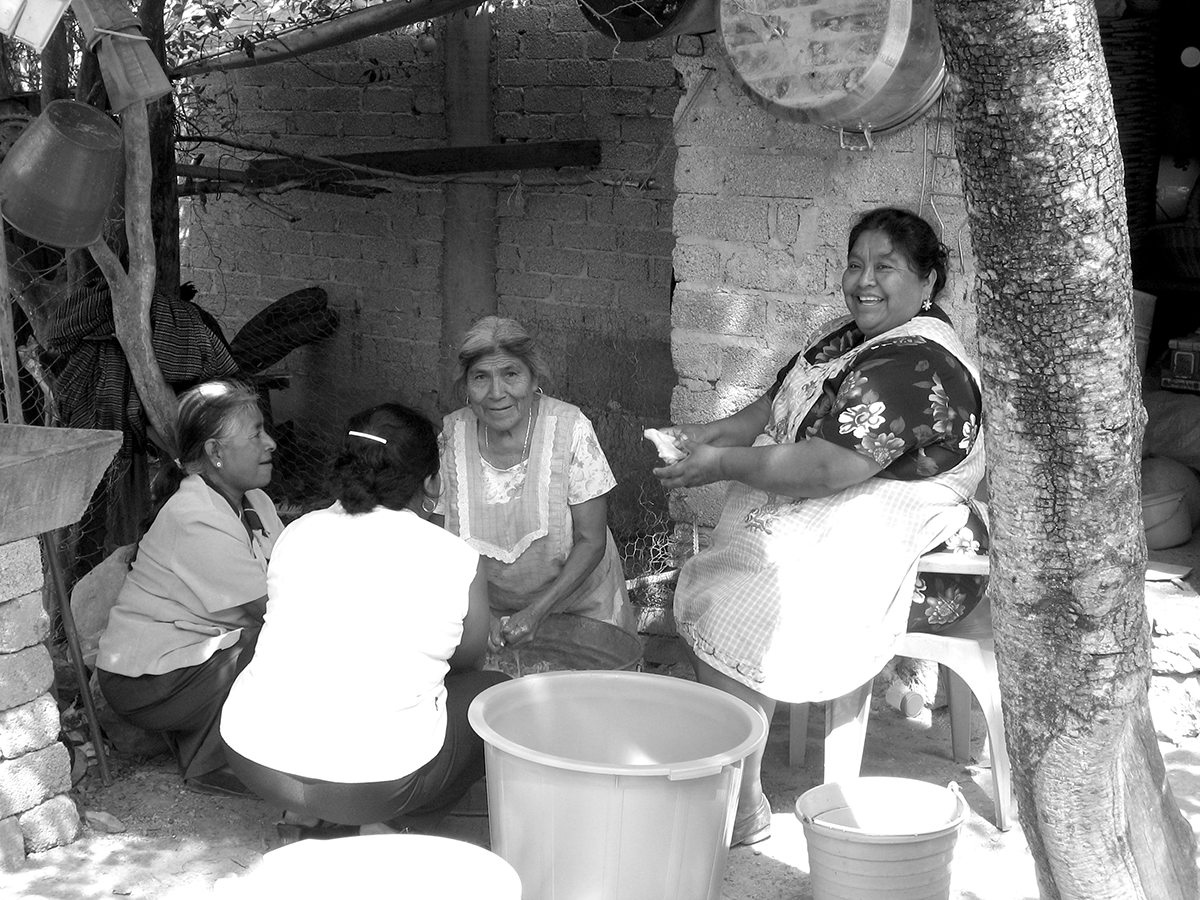
by Lynn Stephen, Distinguished Professor of Arts and Sciences, Director, Center for Latino/a and Latin American Studies, (CLLAS)
I am a woman born in Oaxaca of Zapotec and Mixtec blood. We Oaxacan women ask that a woman be treated with the same rights as a man. Our mission as women is to create, educate, communicate, and participate. That is why we are here occupying the state radio and T.V. station…. We are women who don’t usually have a voice because we are brown, we are short, we are fat, and they think that we don’t represent the people, but we do. WE are the face of Oaxaca. …It is too bad that the government doesn’t recognize the greatness, the heart, and the valor of the women who are here. We are here because we want a free Mexico, a democratic Mexico, and we have had enough. ...They will have to take us out of here dead, but we are going to defend the TV station and radio. –Fidelia Vázquez, testifying inside the Corporacíon Oaxaqueña de Radio y Televisíon (COR-TV), Oaxaca’s public TV and radio station after women took it over on August 1, 2006.
The quote above comes from an interview I recorded in August 2006 as a result of a CSWS-funded research trip with the Américas RIG to forge links with women’s organizations in Oaxaca, Mexico. Little did we know when we set out that we would arrive in the midst of one of the most significant social movements in recent memory in contemporary Mexico. Six years later while on sabbatical partially funded by a fellowship at the Center for U.S.–Mexican Studies at the University of California, San Diego, I completed a book titled We are the Face of Oaxaca: Testimony and Social Movements, forthcoming with Duke University Press (2013). It is Duke’s first book with integral digital video and photographic content and will be published in paper and as an e-book with a website of accompanying digital materials directly accessible through links in the e-book. I am grateful to CSWS for funding the research and earlier website construction phases of this project and to the University of Oregon for partially funding my sabbatical year in 2011-2012.
The book centers on a social movement in Oaxaca, Mexico and the emergence in June 2006 of the Asamblea Popular de los Pueblos de Oaxaca (Popular Assembly of the Peoples of Oaxaca, APPO). APPO, a coalition of over 300 organizations, disrupted the usual functions of the Oaxaca state government for six months. It took over state radio and TV stations and began to construct a more inclusive and participatory political vision for the state, until the Mexican federal police force intervened. A complex mixture of movements— including those of teachers, indigenous peoples, women, students, peasants, and urban neighborhoods—had coexisted in Oaxaca for several decades and were the political soup out of which the Oaxacan social movement of 2006 emerged. The book is preceded by a digital ethnography website that was launched in 2009 with support from CSWS and the Center for Latino/a and Latin American Studies (CLLAS), titled Making Rights a Reality, located at http://www.mraroaxaca.uoregon.edu/.
I worked intensely with a team of students—including website designer Alina Padilla Miller, a graduate student in the UO School of Journalism and Communication (SOJC); Jesse Nichols, former UO undergraduate; translator Magali Morales, who produced the Spanish text on the website; Josúe Gómez, a former graduate in anthropology at UO who helped with translation and subtitling; and my colleague Professor Gabriela Martínez (SOJC), who provided technical expertise, to put together the website.
After the website was launched, I continued to discuss it with the people who had participated in it and others who had reviewed it in Oaxaca. I received many ideas for how to improve and broaden the project. Since most of the participants were also interested in seeing a book produced as well, I concentrated on that project. The conversations and connections I made through the process of working with people on the website resulted in further suggestions for interviews and the video and audio recording of more testimonials I have used in the book.
During the summers of 2009, 2010, and 2011, I continued to interview and record testimonials. Most of these are not included in the website, but became important sources of insights and information for the book. I interviewed local business owners, people involved with the Catholic Church, teachers, artisans, participants in subsequent radio-station takeovers in Oaxaca and others active in creating new community radio stations. I also spoke with participants in barricades, youth activists, and academics. I ended up with a corpus of more than 80 audio/visual interviews with testimonials embedded in them.
As I moved into the third year of interviewing and recording testimonies, I realized that the form of providing testimony—of witnessing, of retelling events and experiences of 2006—was a visceral and emotional experience for everyone I talked with. The urgency with which everyone talked about the social movement and conflict of 2006 almost always resulted in long stretches of reflective narration and the recall of events, feelings, and emotions, which included a strong identification with being “Oaxaqueño,” (Oaxacan—interpreted, of course, from many different perspectives and with multiple meanings. One of the most interesting results of the 2006 social movement was the unification of many different sectors of Oaxacan society under the political identity of “el pueblo de Oaxaca” (the Oaxacan people). The hybrid ethnic, class, and generational differences that came together in APPO and related movements created a new sense of who is Oaxaca, as reflected in the testimony of Fidelia which begins this chapter and became a kind of mini-mantra and analysis for the processes and experiences represented here.
As I immersed myself time and time again in the narratives, I was struck by the fundamental importance of testifying—not only for individuals but also for the social movement. This importance was evident in video-recordings of public events and radio broadcasts as well. The power of oral testimony was amplified not only emotionally for those who did the telling and listening, but also through its reproduction in multiple forms as it was recorded, broadcast, textualized, and then disseminated along multiple transmission channels. I was observing a form of knowledge production that drew from oral archives of knowledge and then reproduced them in conjunction with written and visual forms.
The chapter focused on women’s takeover of public media in Oaxaca and its subsequent impact is one of the most important ones in the book. “The Rights to Speak and Be Heard: Women’s Interpretations of Rights Discourses in Media Take-Overs,” documents the process by which several hundred women took over state and then commercial media (radio and television), opening up key cultural, political, and communication channels—literally and symbolically—that permitted new voices to be heard, new faces to be seen, and alternative models of governance and political participation to move temporarily into the mainstream. Through their experience running radio and television stations these women came to a gendered local vernacular of rights talk that became accessible to many other women and men in the city. The chapter also highlights the crucial security and information role played strategically by movement controlled radio as repression of the movement increased and terminated with occupation by federal police forces after six months.
Every Oaxacan was profoundly affected by the events of 2006. The social conflict revealed in stark terms the lack of rights (in practice) and political participation that the majority of Oaxacans had. It also revealed the potential power and strategic effectiveness of testimony and of the political identity forged around “el pueblo de Oaxaca.” The lasting legacy of the 2006 social movement can be found in the words of Fidelia: “We are brown, we are short, we are fat, and they don’t think that we represent the people, but we do. WE are the face of Oaxaca.” The Oaxacan social movement gave birth to a new set of political subjects—not only those who identify with the words of Fidelia, but others as well. These new political subjects, for example, include the middle-class entrepreneurs and business people who felt that they had to step up and participate in new ways in politics in Oaxaca. Probably the most significant transformations at the personal level happened to women and youth, who were central players during the most powerful periods of the 2006 movement and continue to be the motors of change in Oaxaca and in larger Mexico.
—Other books by Dr. Lynn Stephen include The Story of PCUN and the Farmworker Movement in Oregon (revised 2012); Transborder Lives: Indigenous Oaxacans in Mexico, California, and Oregon (Duke University Press, 2007); Dissident Women: Gender and Cultural Politics in Chiapas (coedited with Shannon Speed and Aída Hérnandez Castillo) (University of Texas Press, 2006), and Zapotec Women: Gender, Class, and Ethnicity in Globalized Oaxaca (Duke University Press, 2005).

